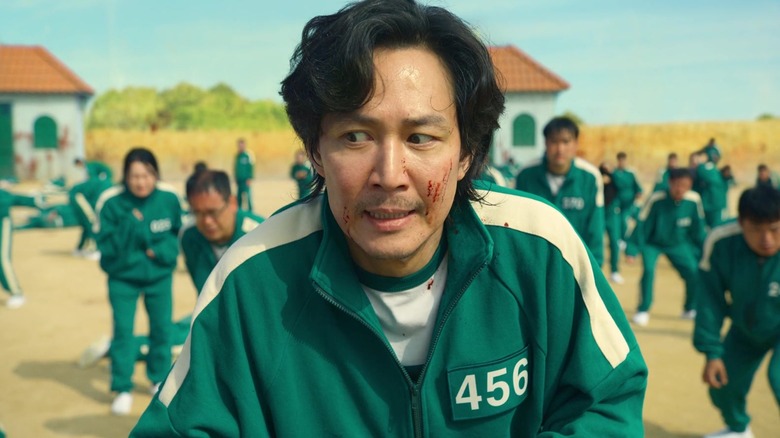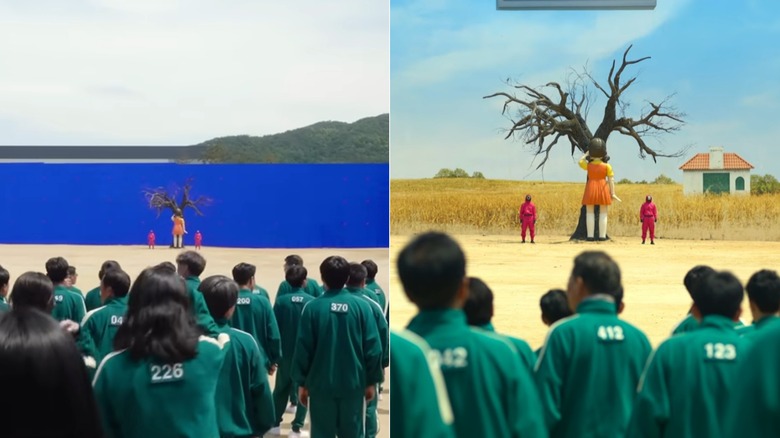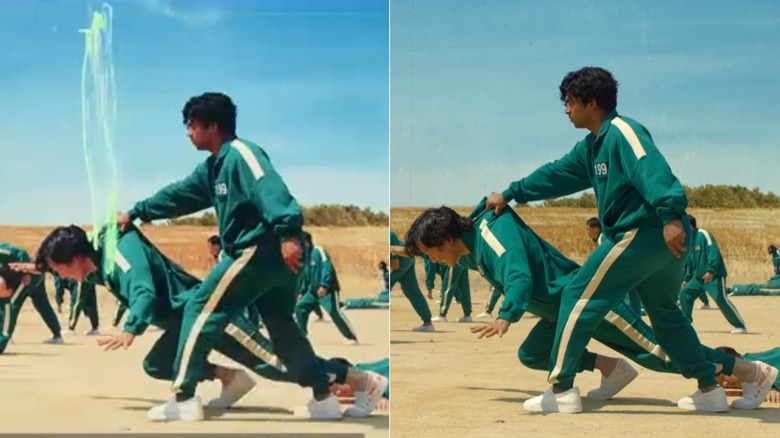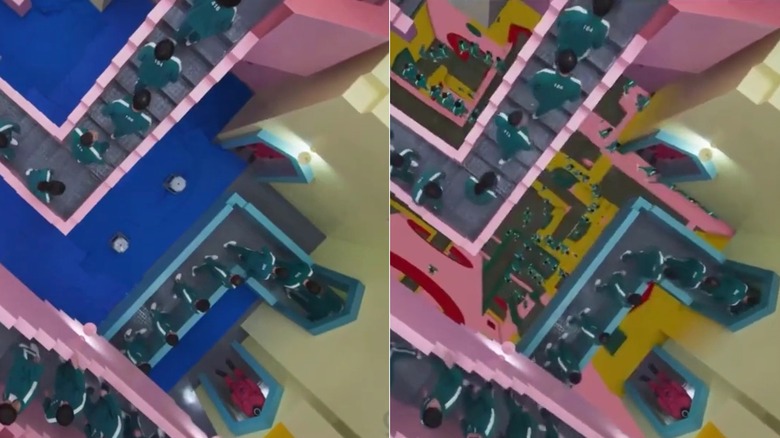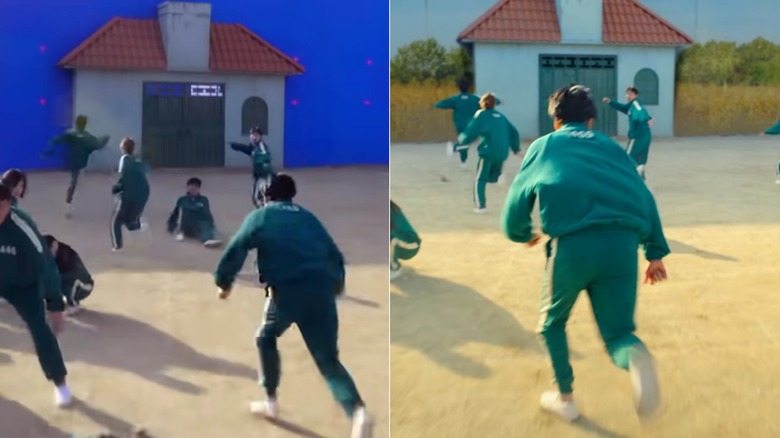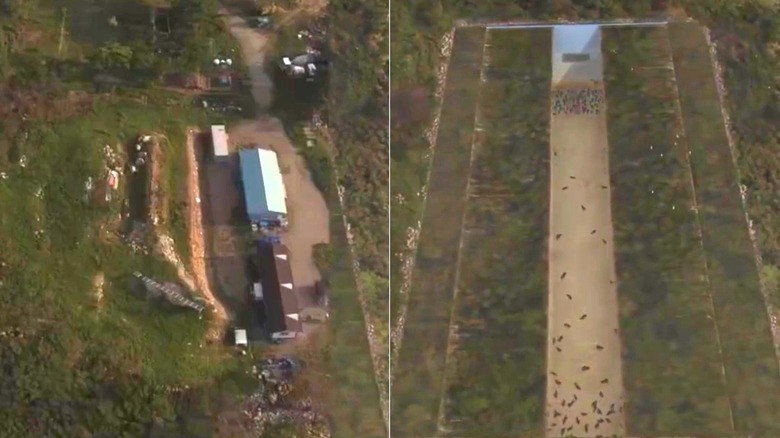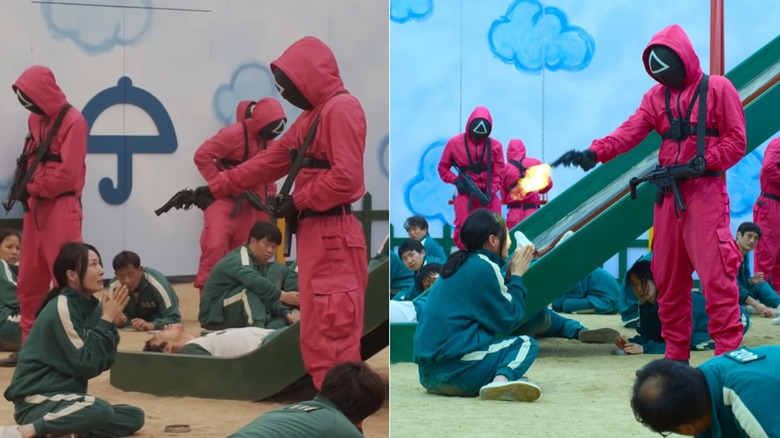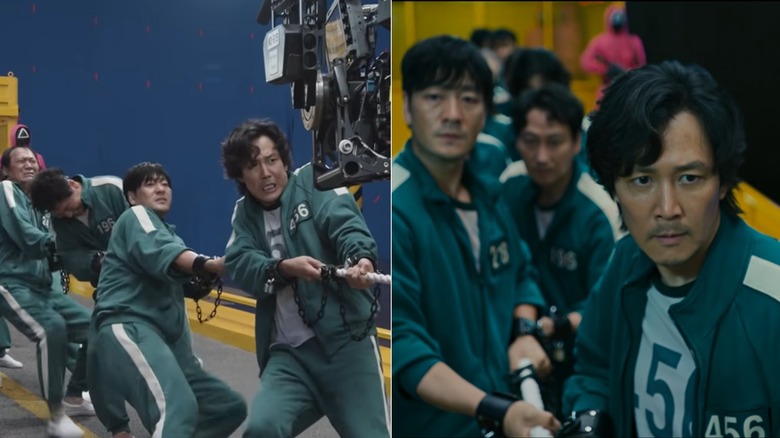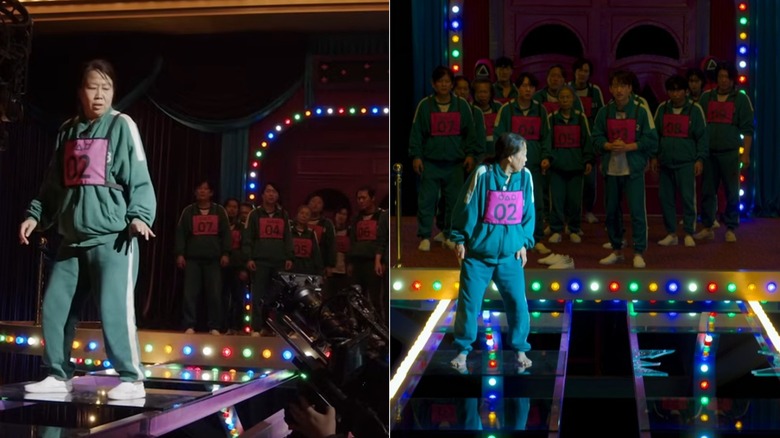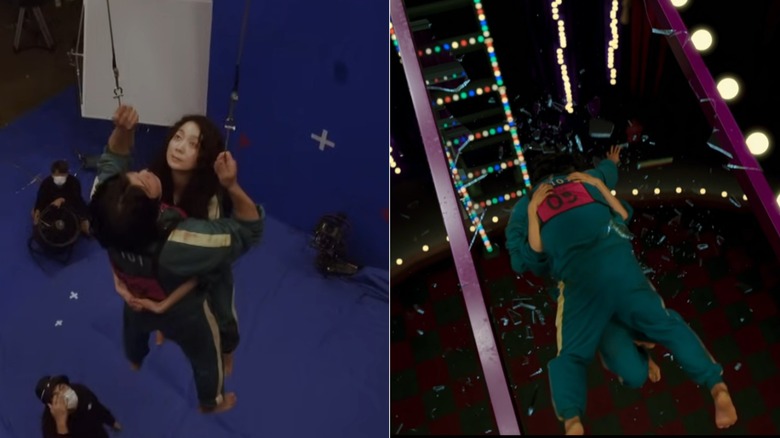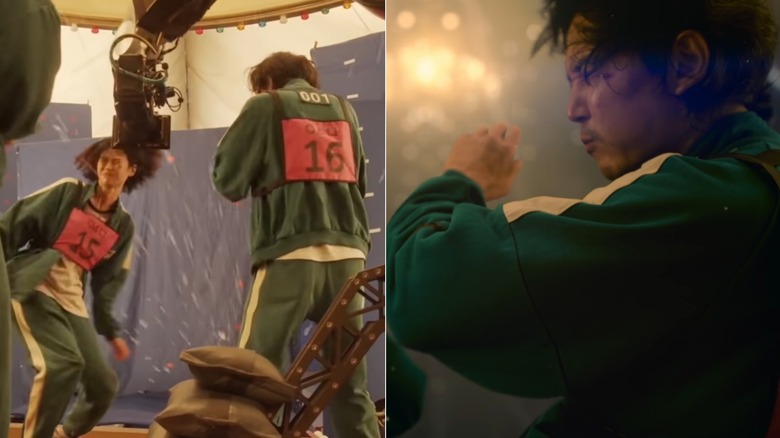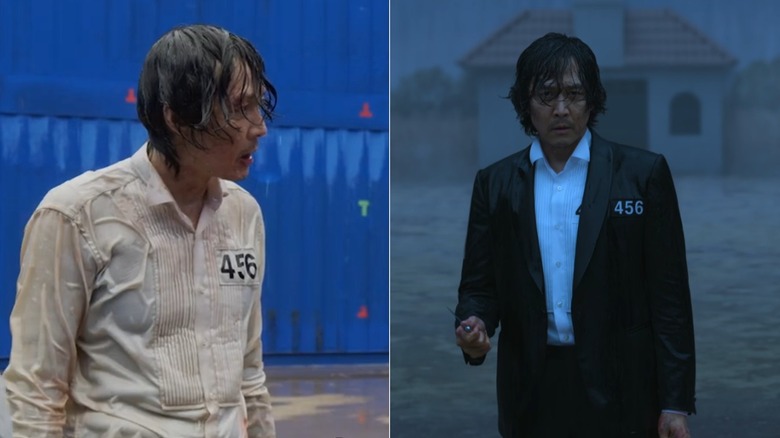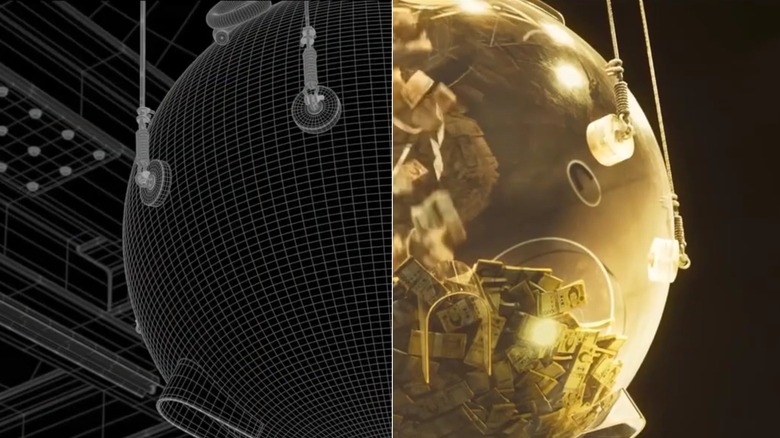What Squid Game Looks Like Without Special Effects
Coordinating a hit TV series with elaborate set pieces and complicated special effects can be stressful – so stressful that you might even lose your teeth. That's what happened to Korean director Hwang Dong-hyuk while he was filming Season 1 of "Squid Game" — the stress of managing the massive production literally caused eight or nine of his teeth to fall out.
Thankfully, reading about special effects is nowhere near as draining as making them. You might be surprised to learn just how much of the show involved visual effects — not just the high-stakes game of tug-of-war and the spectacular explosion of glass shards, but also some smaller moments outside the games and one particular stunt in the Red Light, Green Light sequence. Let's take a look behind the scenes so we can better appreciate all the work that went into "Squid Game." Otherwise poor Hwang Dong-hyuk would have lost his teeth for nothing.
The Red Light, Green Light sequence used over 300 extras
Audiences have voted the Red Light, Green Light challenge as the most disturbing game in "Squid Game." And while the cast and crew didn't have to worry about being killed if they moved, filming this sequence wasn't exactly a walk in the park, either. According to director Hwang Dong-hyuk, Red Light, Green Light was the hardest game to film because there were so many people to coordinate. In addition to the major actors involved in this sequence, there were 300 extras and 20 martial arts actors on the set. Originally, it was planned to include even more; in the initial script, the director envisioned a thousand players, but he quickly realized this was not viable. As Hwang explained to Vanity Fair, "We couldn't create sleeping quarters with 1000 beds, and also more extras meant more money."
Even with only 300 actors, the scene was a nightmare to orchestrate. Since some of the violent deaths were shot in slow motion, it was all too easy for actors to mess up a take and need to start over. "It took about 20 to 30 minutes if we got a wrong take and had to plant the fake blood in them again," Hwang recalled. Whenever this happened, the director would go to a different part of the set and film a different character's death while the crew cleaned up the fake blood and got the initial actor back into position again. When you're filming such a complicated set piece, you can't afford to waste a second.
Lee Jung-jae was dangling from a wire
One particular shot in the Red Light, Green Light sequence was especially tricky to film: the moment when Ali (Anupam Tripathi) grabs Gi-hun (Lee Jung-jae) to keep him from falling. It wasn't easy for the actors to hold that awkward position. It was also uncomfortable, according to Tripathi, who told The Swoon, "When I grabbed Jung-jae in Red Light, Green Light, I think I grabbed him a little too hard, but he was very nice about it."
This particular shot was not only strenuous on the actors – it was also physically impossible. Hwang Dong-hyuk told Vanity Fair, "We actually used wires because, no matter how strong someone is, you can't really hold a man like that." He added that the wire made Jung-jae's shirt lift in an unnatural way, so not only did the effects team need to edit out the wire in post-production, but they also needed to use visual effects to tweak Gi-hun's uniform; otherwise, it would have been painfully obvious there was a wire underneath. Hwang and his crew joked that Gi-hun probably would have been safer if Ali had just let him fall, since it's possible he would have hit the ground before the doll saw him, and then it would have been much easier for Gi-hun to remain still. Certainly, that would have meant less of a hassle for the visual effects team.
The arenas were digitally modified to look bigger
Many of the locations in "Squid Game" were constructed in real-life, with the production's crew building everything from the bunk beds to the arena for the marbles game. However, that doesn't mean these scenes didn't require computer-generated imagery (CGI). The VFX team needed to extend the sets digitally. As visual effects supervisor Cheong Jai-hoon told GoldDerby, "We did a lot of computer graphics work at the post-production stages to connect the different spaces and to create space that wasn't able to be created in reality."
For example, the background of the tug-of-war room was modified digitally to make the area seem even more cavernous than it actually was. The effects team did indeed build the tug-of-war platforms, but — except for a handful of shots showing the players being pulled over the edge, which were filmed on a separate set — the actors weren't very high off the ground. Likewise, while the "Squid Game" team did construct a segment of the room with all the stairs, they used CGI to extend the set and make it seem like the stairs went spiraling deep into the ground. (And, if you're wondering why these stairs look so familiar, it's because they were based on a famous piece of art.)
The background of the Red Light, Green Light arena is CGI
You might be surprised to learn that the painted background of the Red Light, Green Light arena is actually CGI. That may seem strange, seeing as the Red Light, Green Light arena could have easily been built in real life. Why did the VFX team go through the trouble of using a blue screen instead of just painting the wall?
To put it simply, the director hadn't made up his mind yet when the sets were built, so they used CGI to give him the option to change the design later. At first, Hwang Dong-hyuk considered making the arena walls more colorful. However, the visual effects supervisor had a different idea. "Maybe we should have a buffer zone for the first episode," Cheong Jai-hoon explained in an interview with the Visual Effects Society. "Because if we just go all out on the colorful and the flashy from the very beginning ... people might find it childish." Jai-hoon likened the sets to "The Truman Show" and how the movie's artificial world seems almost (but not quite) real. In the end, the director settled on the final design, a backdrop that is just real enough to be convincing and just fake enough to feel unsettling.
Even with the blue screen, the set still gave the actors with plenty to inform their acting. As actress Jung Ho-yeon told Vanity Fair, "When we were there, the tree and Young-hee [the doll] were enough to make us feel scared."
Some of the sets outside of the games contain CGI
It's not just the trippy game arenas that used VFX to bring them to life. The creators of "Squid Game" also used CGI to build environments outside of the games.
One VFX breakdown shows what the famous overhead shot of the island at the end of the first episode would look like without visual effects. The massive arena with a retractable roof was actually filmed on a modest patch of land that only contained a couple of warehouses — the rest was added digitally. Likewise, the sequence where the cars leave the ferry and enter the island is not what it appears to be. In an interview with the Visual Effects Society, Cheong Jai-hoon explained, "People think that it was actually filmed on an island, but it was just like a really random part [of] Korea." In this landlocked filming location, the crew took advantage of an existing waterway and then added the rest using CGI.
Believe it or not, the entire airport from the season finale is fake. The show's creators originally intended to film the scene in a real airport, but they discovered at the last minute that they would not be able to use the location due to COVID-19 restrictions. Instead, they shot the final scene of the final episode in the studio and then used computer wizardry to transform it into an airport.
The director shouted bang each time a gunshot went off
As far as Hwang Dong-hyuk is concerned, the safety of his cast and crew is of the utmost importance. So when it came time to film the grisly player eliminations, the director took extra safety precautions for any scenes involving guns. In fact, for some scenes, even the sounds of the guns firing were fake.
While Hwang shot some of the death scenes using realistic gunfire sound effects, some behind-the-scenes footage reveals that there were other times when he only used his voice. All he needed to do was shout "Bang!" In multiple clips — mostly moments from the honeycomb game, when a random player is shot offscreen — we see the actors responding to the director's cues. Each time the director yells "Bang!," Lee Jung-jae and the other actors flinch as if they hear a real gunshot. If we were in their shoes, we'd probably flinch, too.
During tug-of-war, the actors played against a machine
Thanks to some behind-the-scenes footage that takes us inside "Squid Game's" tug-of-war scene, we now know what it was like to film this challenging sequence. It was so draining that the actors had to rest and catch their breath between takes, with some of the cast members resting on the short yellow rail at the edge of the tug-of-war platform. Meanwhile, Lee Jung-jae had a little stool that he would pull up.
Most of the actors agreed that the tug-of-war sequence was the hardest to film. In a special behind-the-scenes featurette for Still Watching Netflix, actor Park Hae-soo said, "I learned that Tug of War requires incredible physical strength. I did not realize this until I filmed Squid Game." Meanwhile, Heo Seong-tae told The Swoon, "I really gave it my all. I threw up so many times."
What's interesting is that when we see Gi-hun and his teammates playing tug-of-war, there isn't a team of ten players pulling on the other end of the rope. Instead, each time we see a team playing tug-of-war, the actors are actually competing against a special machine designed to pull on the rope. Speaking with The Swoon, Lee Yoo-mi explained, "We were really using all of our strength to play against a machine, not a group of people. So no matter how hard we pulled, we couldn't win." A game that's impossible to win? That sounds like Squid Game, alright.
The glass bridge was actually close to the ground
You'll probably be relieved to learn that most of the Glass Stepping Stones challenge was actually filmed close to the ground. Of course, the set was still 1.5 meters (or approximately five feet) off the ground, which allowed the crew to film shots from underneath the glass bridge as well as stage the shots where characters fell to their deaths. Behind-the-scenes footage shows one extra leaping onto the space where a glass panel should be – except there's no glass. Instead, there's a platform (which was later erased by VFX) that drops quickly and smoothly the moment she puts her weight on it. After it falls, the actress crouches down to make sure her body will no longer appear in the shot.
Even though the bridge wasn't as high in real life as it appears in the show, it was still plenty convincing for the actors. S visual effects supervisor Cheong Jai-hoon explained in an interview with Still Watching Netflix, "We could have actually made it lower. But Director Hwang wanted it at that height in order to instill some fear in the actors." Sure enough, this "Squid Game" set actually scared some of the show's stars. Actress Jung Ho-yeon shared that it was nerve-racking jumping from panel to panel. Speaking in a behind-the-scenes featurette, Hwang Dong-hyuk concluded, "The game was real, and they felt real fear. Their bodies showed that fear."
The showrunners built a separate glass bridge that was higher up
Not every scene was filmed from such a comfortable height. For a handful of shots in the glass bridge sequence, the actors actually filmed on a separate set, one that was approximately 6 meters (or about 19 feet) off the ground. The VFX team later composited the two sets digitally. Behind-the-scenes footage shows Mi-nyeo (Kim Joo-ryoung) and Deok-su (Heo Seong-tae) being raised on a harness, along with the glassmaker (Lee Sang-hee) taking a tumble from the glass bridge. (He lands in one piece, thanks to his harness and the safety mats.) "Even though it was filmed safely," Heo told The Swoon, "we had to fall from a high place and no stuntmen were used. It was exhilarating." Even from the safety of the editing room, the footage from these scenes gave film editor Nam Na-Young vertigo.
As well, to show the scale and the stakes of this game, the show's creators built a third set just for filming all the broken bodies of the contestants who hit the floor. Cheong Jai-hoon was the one who suggested this, so we have him to thank for putting those disturbing images in our heads.
The glass shards were a mixture of practical effects and CGI
To film the unforgettable scene where the glass bridge explodes, the "Squid Game" team shot in slow-motion using a Phantom Camera, a piece of equipment that can record at 3000 frames per second. As a result, the actors had to be very careful not to turn away too soon; otherwise, the timing wouldn't line up. Between takes, a crew member would come in and make very precise slashes in the sleeve of Jung Ho-yeon's uniform so that it would look as though the glass was cutting her clothes.
For the glass itself, the effects team started with a practical effect, spraying the three actors with particles designed to resemble glass. Afterward, the actors needed to shake these particles from their hair. Of course, the rest of the bridge exploding was shot separately. At first the visual effects team tried shooting it in real life, but they weren't happy with that result, so they went with a CGI explosion of glass. CG supervisor Kang Moon-jung told the Visual Effects Society, "A lot of people thought that ... CG can never be better than the real shot. But actually, for this sequence, CG turned out to be even better than the real shot." Of course, that didn't mean it was easy, and the visual effects team had to erase and replace the reflections in every single glass shard.
The actors were freezing when filming the final game
One of the most intense "Squid Game" sequences is the final game, in which Gi-hun and Sang-woo (Park Hae-soo) play a Korean schoolyard game to the death. (Of course, some would argue that this was not actually the last game, at least according to this theory about the final game that changes everything.) It was filmed in the same location as the Red Light, Green Light sequence, yet the set couldn't look more different. The lighting is more overcast, and the crew used sprinklers to simulate a heavy downpour. Various behind-the-scenes clips show the camera crew wearing ponchos and using waterproof coverings to keep their equipment from getting wet.
However, the actors were not so lucky. They had to shoot an intense fight scene while they were soaking wet, and it was freezing outside. As Lee Jung-jae recalled in an interview with Entertainment Weekly, "It was in winter, so the weather was very cold ... I remember filming that scene for about four days in the rain with the sprinkler, so it was very emotionally and physically tough." It's safe to say that not all of the exhaustion shown on the characters' faces is acting; you try hopping on one leg in wet clothes in freezing temperatures and see how far you get.
Even seemingly simple scenes used visual effects
You'd be surprised how often Netflix has utilized post-production visual effects without you noticing, but even some of the most ordinary shots in "Squid Game" would look different without special effects.
For instance, the ceilings of most of the arenas were inserted digitally after filming. In the Red Light, Green Light arena, the walls of the set were just a bit taller than the blue screen, meaning they cast shadows on the ground that wouldn't make sense in the final scene. As a result, the VFX team needed to digitally erase some of the shadows. And while you would think that the giant piggy bank containing all the prize money could be easily filmed in real life, this is actually not the case. The filmmakers did build a physical piggy bank, but they soon realized that it wouldn't work; the plexiglass was so reflective that it was hard to actually make out the money inside when a spotlight was shining on it. So they created a CG version of the piggy bank instead.
All of these VFX shots probably slipped under the radar of most viewers, and that's exactly how the showrunners like it. As Kang Moon-jung told the Visual Effects Society, "What Director Hwang wanted and what the VFX crew wanted was ... [to not make] CG look like CG, so people can just take it for granted." So if you didn't notice these invisible visual effects, then that means the VFX team succeeded in their goal.
